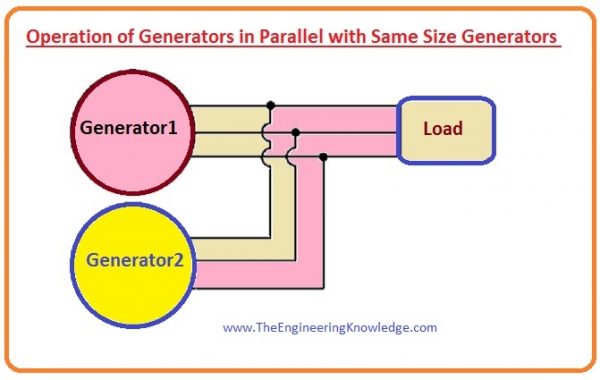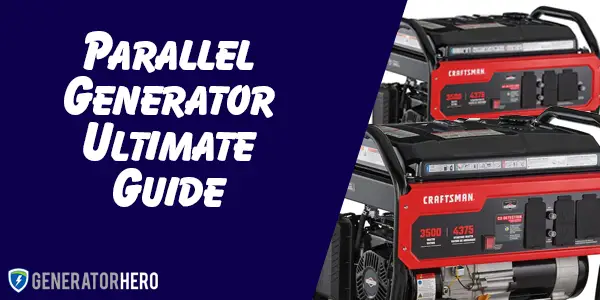You may have purchased an inverter generator with lower wattage that fits your original purpose, but now you need more power. What do you do?
If your current inverter generator can run in parallel, you are in luck. Running two generators in parallel or synchrony can boost your power to meet your everyday needs. A parallel operation can save you the expense of buying a more significant, powerful generator.
If you need to run high-draw appliances such as air-conditioners, a smaller watt inverter generator will not produce enough non-peak load watts to sustain power flow. Connecting another inverter generator can boost the power output enough to handle not only the a/c but also other appliances simultaneously.
Suppose you are operating small electronic devices, such as computers or cell phones. In that case, the inverter generators offer a more stable and constant flow of energy to protect those sensitive items from damage.
Table of Contents
- How Do Parallel Generators Work?
- Should I Buy a Larger Generator Instead?
- Issues with incompatible generators
- What are the Benefits of Running Parallel Generators?
- What Should I Look for in a Parallel Generator?
- The Importance of Generator Design
- How Much Will Parallel Generators Cost?
- Placement of Generator(s)
- Conclusion
- FAQ
How Do Parallel Generators Work?

Simply stated, running generators in parallel means that two are running with their cables connected to a single line that delivers their combined power.
The first step is the make sure the two generators are rated the same for the amperage and voltage they produce. Attempting to connect two different generators that do not match can cause damage to one or both.
- Match the alternator pitch – this must be compatible
- Be sure the voltage output is the same on both generators
- Each generator must have the same frequency
- You must use a parallel cable designed to run between the generators
The second step is to connect both generators using a parallel kit designed for that purpose. Follow the directions provided in either your owner’s manual or the parallel kit for the specific steps for your generator.
There is a sequence to powering the generators, so be sure to follow the steps provided in your owner’s manual or instructions from the parallel kit.
The third step is to connect the generators via the parallel kit cable to the power (load) input for your home, business, or RV. Again, follow all directions precisely to avoid problems.
Should I Buy a Larger Generator Instead?
You already have an investment in your current inverter generator. Buying a more significant higher watt generator will:
- Cost significantly more
- Be more expensive to maintain
- Be less fuel-efficient
- Be louder to operate
- Possibly be more challenging to move or transport
- Be less likely to be compatible with your current generator
Issues with incompatible generators
You may be wondering why it is crucial to have “twin” generators in the parallel process. If you hook up an incompatible generator that has less power, the entire purpose will be useless. The system you have tried to enhance will be limited to the smaller voltage output.
What are the Benefits of Running Parallel Generators?
Running two inverter generators in parallel also has benefits beyond producing more power. They can:
- Be easier to maintain than larger generators
- Be easier to transport
- Produce more power together
- Be easier to control the load draw
- Can be run together or separately during an emergency
When considering your power needs, you may decide that you have different requirements for different times. If you live in an area prone to long-term power outages following storms, you will need to determine if your power needs will last for a few days or just a few hours. Will you need to keep refrigerators and freezers running to avoid food spoilage, or will you just need lights and small appliances?
Each situation will be different, and the power needs will require either one inverter generator or two in parallel. If you have a 2500-watt generator (at normal load), adding a second 2500-watt generator in parallel will give you 5000 watts of power (at normal load) draw.
What Should I Look for in a Parallel Generator?
- Not every generator is parallel compatible. Most inverter generators have parallel capacity. Hopefully, the one you have will run in parallel, but if purchasing a generator for the first time, it is wise to get one that does. Check your owner’s manual or go online to your generator’s manufacturer to confirm your status.
- Once you know that your generator is parallel friendly, you can find a compatible generator by searching online manufacturers. You will find dimensions and statistics listed for each model, as well as parallel options.
- Know your wattage needs. If you know that you’ll need more power (at times) than one generator can provide, you’ll be able to figure the maximum capacity to operate two generators in parallel. For example, two generators rated at 2000 watts, in parallel they will produce 4000 watts.
The Importance of Generator Design
There are some design choices to consider when purchasing a generator:
- How far from the load will your generator(s) be placed? Longer distances may require more voltage.
- What type of fuel will you need to use?
- How many operating hours will your generator run based on the fuel tank size?
- Is there enough ventilation for proper cooling?
- What will your costs for regular maintenance be?
- Is the generator transported or stationery?
These are all important considerations because they determine the end efficacy of the system.
How Much Will Parallel Generators Cost?
The cost is essential as you plan your budget. How much a generator will cost is going to depend on your use and the power needs.
Your needs will vary depending on where you plan to use your inverter generator(s). While still well constructed, a stationary generator will not need the framework to protect it like those made for job site purposes. If you store it for use at your home, the costs may be less than needing generators designed for rugged outdoor use, camping, or worksites.
Prices for a lower watt inverter generator may run from $350 and up, while a more significant wattage generator could start at $900.
Placement of Generator(s)
It is essential to consider the placement of your inverter generators when running in parallel. Remember that water is not a friend to your generator, so keeping them safe from humidity is vital. As well, maintain your generator(s) and keep them clear of dust and debris in a well-ventilated space.
An important thing to remember is if one generator fails, you have a backup with the parallel generator. If you only have one large generator and it fails, you will be without power.
Conclusion
Considering the size of your inverter generator, its location, and your overall power needs will determine your investment. Prior research will benefit your decision and prevent a poor choice when your family or business needs electricity the most.

FAQ
Are generator parallel kits universal?
A generator parallel kit should work between them as long as they are equal in wattage and voltage. Check the outlets on both generators to make sure the plugs match.
Why do we parallel generators?
Running two inverter generators in parallel can boost power to meet your everyday needs. A parallel operation can save you the expense of buying a more significant, powerful generator.
When the higher power is not needed, you can choose to operate one generator. When additional power is required, connect the second generator to double the capacity.
How do generators share the load?
As you can see in the graph posted at the top of the article, a parallel kit is attached to the two inverter generators. The power from the two generators combines before going into the load receptacle. The power output of each generator doubles going to the home, business, or RV.
Can I use different brands of generators to parallel?
The answer is yes; however, they must both be of equal voltage and wattage. Always check the manufacturer’s recommendations.
